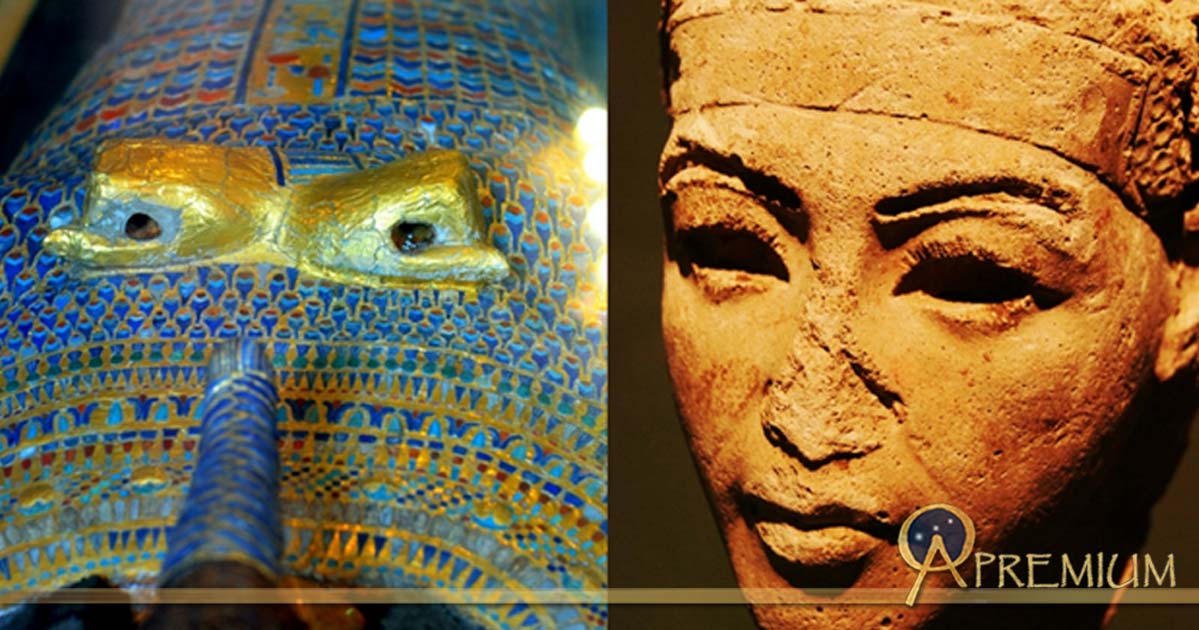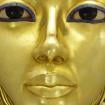The Magic, Mystery and Madness of Tomb 55: Shadowy Sovereigns and Risky Reburials–Part IV
The German Egyptologist Walther Wolf was unsparing in his description of Akhenaten, calling him a man who epitomized “sick ugliness and nervous decadence”. The greatest irony of the entire Amarna episode was that this pharaoh, who had vehemently denounced the Amun-Re cult from faraway Akhetaten, came to be buried in the traditional Theban royal necropolis. But not all believe Akhenaten’s mummy has been discovered.

Painted wall relief shows Akhenaten and Neferiti worshipping the Aten. Tomb of Meryre II, Tell el-Amarna. (Photo: Oliviero Piccinali)
THE HUNT FOR AKHENATEN
Opinion remains firmly divided between the Akhenaten and Smenkhkare camps over the identity of the Tomb 55 body (the latter is believed by some scholars to have been a son of Amenhotep III and younger-brother to Akhenaten). It is supposed that Smenkhkare ruled for a very brief period in the interregnum between the death of Akhenaten and Tutankhamun assuming the throne. Perhaps, this shadowy individual was a co-regent during the last years of Akhenaten’s reign itself, before becoming an independent pharaoh; we have as yet been unable to ascertain any of this.
Beginning in 1916, with anatomist Georges Daressy’s theory that the coffin had originally been made for Queen Tiye and then adapted for a king's burial; every Egyptologist and anatomist who has ever been involved in this “identification project” since then—Rex Engelbach, Guenther Roeder, R. G. Harrison, Dr Zahi Hawass, among others—has proposed the names of the two individuals based on their interpretations of the evidence at hand, and more importantly, DNA tests, that have failed to solve the riddle to the satisfaction of everyone concerned.
Through the decades, anatomical estimates of the body’s age at death have ranged from as low as 20 years to 60 years on the higher side. An interesting proposal by the anatomist Douglas Derry dwelt on the stark physical similarities he claimed exist between the KV55 corpse and its mooted relative, Tutankhamun (half-brother or son, depending on the view one subscribes to). Signs of Scoliosis, an impacted jaw and cleft palates were some of the similarities cited. At any rate, one thing is clear, if indeed the mummy belongs to Smenkhkare, he was certainly a part of Tutankhamun’s family—regardless of whether he was the boy-king’s father, brother or uncle.
The second, exceptional rishi coffin of the boy-pharaoh is believed to have been appropriated from Smenkhkare, and Howard Carter was the first one to notice how dissimilar the face appeared to known representations of Tutankhamun. “The second coffin’s face is certainly that of a man, and of quite a different aspect, even allowing for the difference in scale. With no resemblance to Akhenaten to be seen, the only option would seem to be Smenkhkare,” explains Dr Dodson.

A plaster face-study identified as King Smenkhkare from the Neues Museum, Berlin. (Inset) A terracotta mold with the throne name of this ephemeral ruler. Los Angeles County Museum of Art. (Public Domain)
However, Russian Egyptologist YY Perepelkin, who had demonstrated that Kiya was the owner of the Tomb 55 coffin, by citing this queen’s existing titulary, revealed that the coffin had in its final form clearly been intended for Akhenaten himself, though curiously the adaptations could only have been made some years after his death. Dr Nicholas Reeves explains why he is reluctant to accept suggestions that the Tomb 55 mummy belongs to Smenkhkare: “It cannot be emphasized too strongly that there is, in fact, absolutely nothing in the archaeological record which makes any mention of or allusion to Smenkhkare, whose claimed links with the Tomb 55 deposit are wholly illusory.”
Noted Geologist and Egyptologist Stephen Cross offers supporting views on the contentious subject, “If we study the archaeology of the site of KV55, as I have, then it dictates that the occupant of the coffin was Akhenaten. There are no cartouches of Smenkhare at all. That this was a reburial from Amarna is not disputed, but the body has been consistently aged as too young to be him.” So, given this multitude of tendentious interpretations, where then does the enigmatic Smenkhkare lie buried? Could his body have been destroyed in antiquity, or did it survive the ravages of time – hidden away in a secret tomb in the Valley of the Kings down to this day?
This FREE PREVIEW is just a taste of the great benefits you can find at Ancient Origins Premium.
Join us there ( with easy, instant access ) and reap the rewards: NO MORE ADS, NO POPUPS, GET FREE eBOOKS, JOIN WEBINARS, EXPEDITIONS, WIN GIFT GIVEAWAYS & more!
- The Magic, Mystery and Madness of Tomb 55: Seeking the Amarna Dead–Part I
- The Dakhamunzu Chronicles: End Game of the Sun Kings—Part I
- A Tough Commute: Long Hike to Work in the Valley of the Kings Caused Laborers to Suffer from Arthritis
- A Pharaoh Thrice Buried? The Mystery of the Tombs of Pharaoh Akhenaten
Top Image: Collection of Egyptian Art, design by Anand Balaji (Photo credit: Heidi Kontkanen); Deriv.
By Anand Balaji




















